1976 Cadillac Fleetwood Brougham d’Elegance: The Pride of ’76
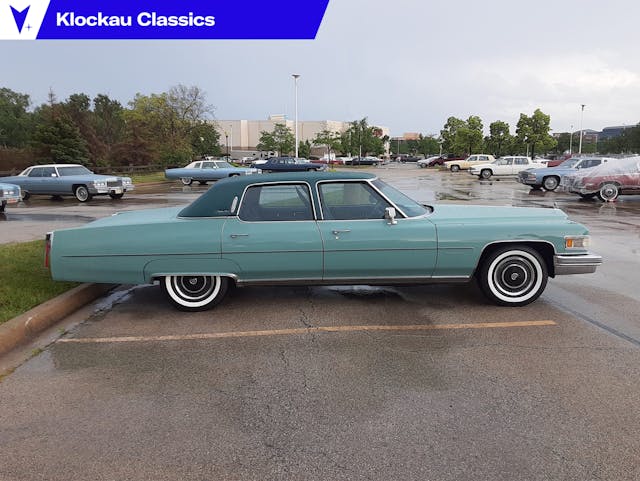
This was it. The last roundup. Picture it: 1976. All manner of fine large cars were available, from Chevrolets and Plymouths to Lincoln Continentals and Chrysler New Yorkers. And Cadillacs.
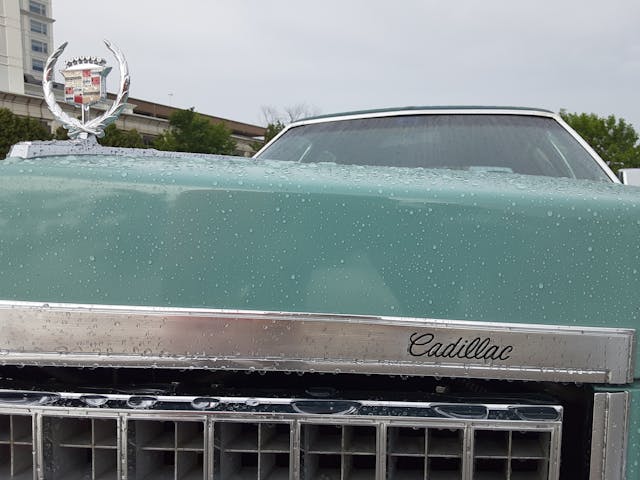
It was a great year for Cadillacs. And it was all glorious sedans, coupes, and, of course, the Eldorado convertible. All cars! No trucks—thank goodness. Trucks? Trucks weren’t luxury, at least not then. Long, low, and wide was the style, not short and stumpy like 90 percent of cars today.
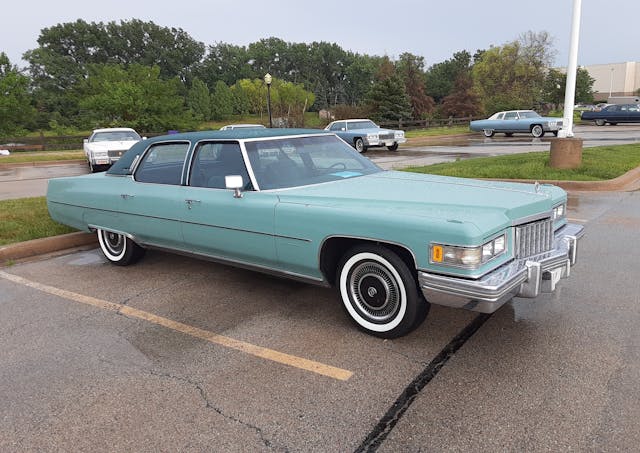
And colors! Oh, the colors. And fabrics. It wasn’t just black and tan leather, or some cheap-looking, mouse-fur fabric, which seems to be your only choice on many new cars. Want white leather with navy carpet in your Eldorado? No problem. Firethorn Red with matching vinyl Landau top on your Coupe de Ville? You betcha.

Or perhaps Dunbarton Green with a dark green padded vinyl roof with matching dark green cloth, as seen on our featured car. The Fleetwood Brougham was the top “owner driven” Cadillac. And while the standard Fleetwood Brougham was an extremely plush car, there were two available upgrades to make it even more sumptuous.

The first was the Fleetwood Talisman, which I devoted a column to a few years back. In short, it added a front center console with seats trimmed in Medici velour in a rampantly decadent tufted style. Outside, a padded Elk Grain vinyl roof and turbine wheel discs were added.
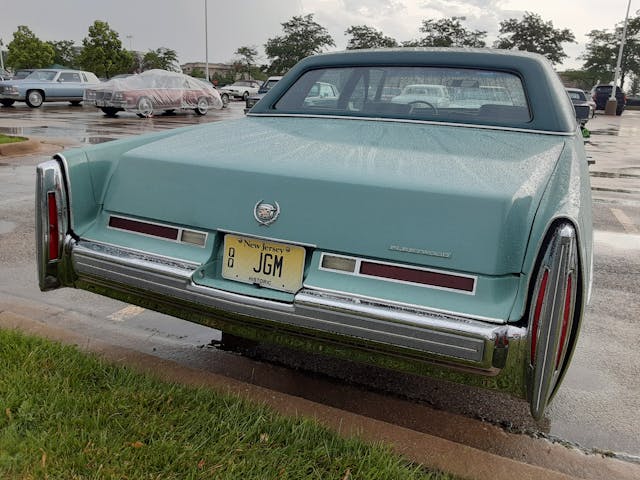
The original ’74 Talisman had been even more over the top, with both front and rear center consoles, making it the only four-passenger Cadillac available that year. But starting in 1975, the three-place rear bench seat replaced the rear, cocooned-console setup.
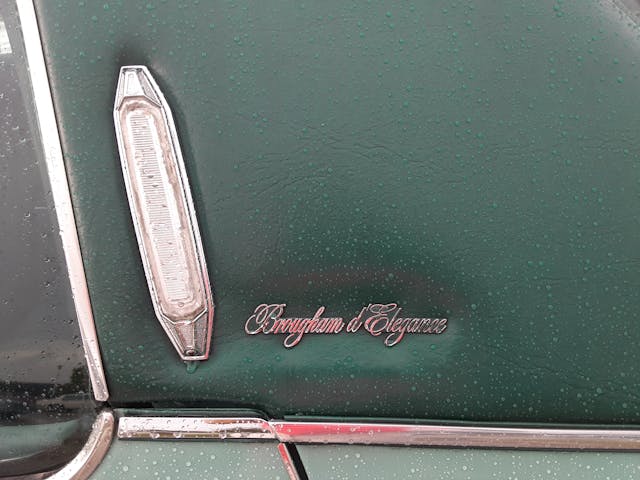
The second trim package was the Brougham d’Elegance. Like the Talisman, it had the exterior turbine wheel covers and padded roof, but the seats were different. This time they had a floating pillow style—Cadillac called it “Cadillac Contoured Pillowed Seats.”
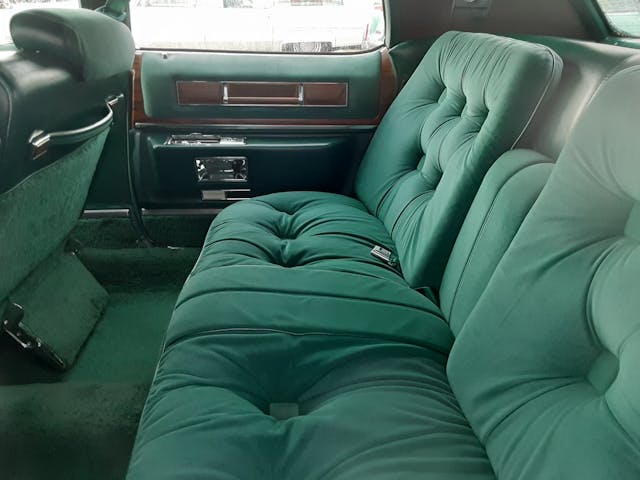
As my 1976 Cadillac brochure explained, “The Brougham d’Elegance seats are trimmed in handsome Mansion Knit, available in Light Gray, Black, Dark Blue, Dark Blue-Green and Light Buckskin. Other luxury touches include Mansion-trimmed seat back storage pockets, deep pile carpeting, turbine-vaned wheel discs, opera lamps, 50/50 Dual Comfort front seats, padded Elk Grain vinyl roof and brushed chrome door moldings.”
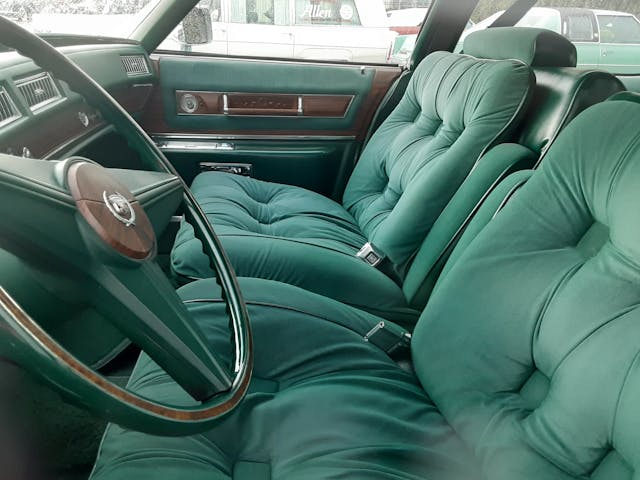
These were, and are, imposing cars. The Fleetwood Brougham rode a 133-inch wheelbase (Calais and de Villes had a 3-inch shorter span) an overall length of 233.7 inches and a curb weight of 5213 pounds. Like all other Cadillacs except for the new “international-size” Seville, under the hood was a 500-cubic-inch V-8, breathing through a 4V “Quadrajet” carburetor—although fuel injection was an optional (and temperamental) extra.
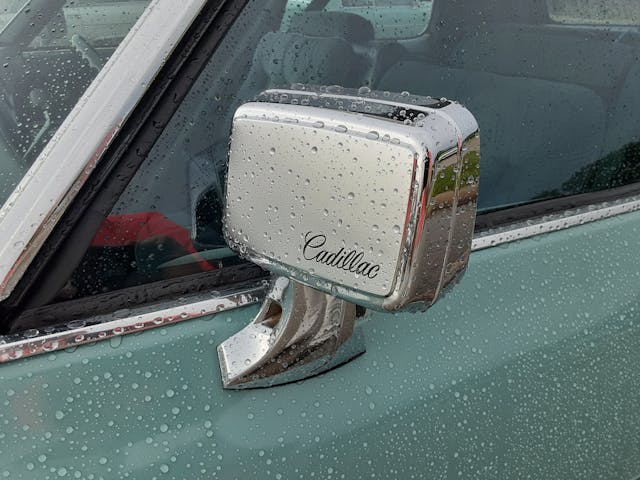
In 1976, Cadillac set another record for sales (the previous record came in ’73), with 309,139 built for the model year. Of course, the all-new Seville played a part, but it was still an impressive number for a luxury make. All the hoopla about the “last convertible,” the 1976 Eldorado, probably also contributed to the bump.

As the showroom brochure extolled: “With its individually longer wheelbase (three inches longer than Sedan de Ville) … with its stately beauty that is both spirited and dignified … with its roominess and refinements for 1976, this is indeed one of the world’s great sedans. The ride: superb. Luxury abounds.”

The 1976 Fleetwood Brougham had a $10,935 base price (about $58,750 today) and was, of course, very well-equipped, even with zero options. The d’Elegance package added $885 ($4755) to the tally. A total of 24,500 were built for the year, but I was unable to determine how many were d’Elegances.
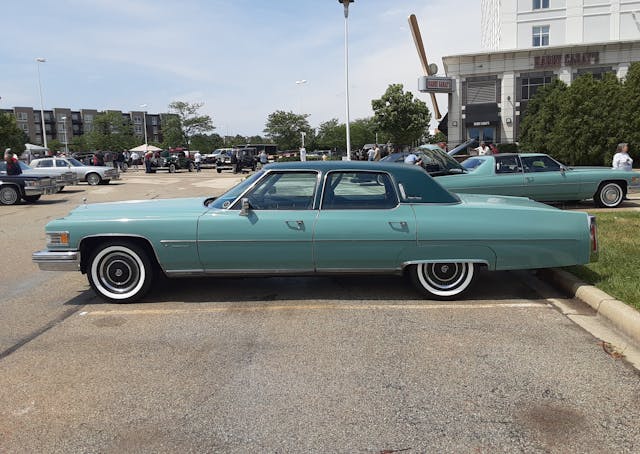
Standard features included Automatic Climate Control, Soft Ray tinted glass, an automatic parking brake release, quartz digital clock, a color-keyed litter container (mounted up front in the passenger footwell), cigar lighters, a visor vanity mirror, and the robust Turbo Hydra-Matic automatic transmission.

Fleetwood Broughams also had as standard equipment a signal-seeking AM/FM stereo with power antenna, automatic level control, and 60/40 Dual Comfort front seats—although that last item was replaced with the 50/50 Dual Comfort front seats on d’Elegances.
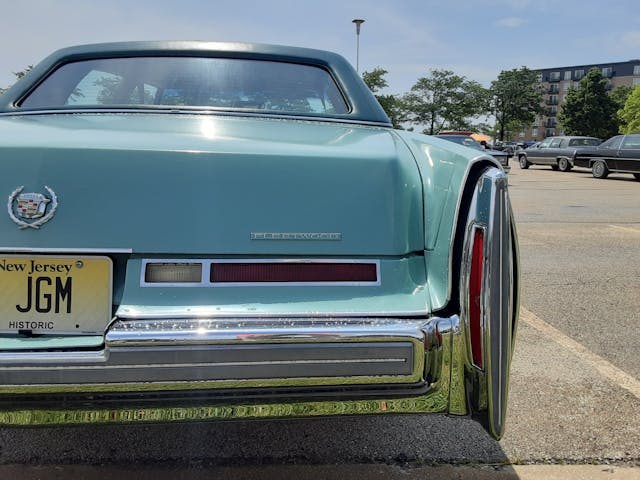
What’s cool about social media is that sometimes I connect with the owners of cars I’ve photographed (and ogled over). That was the case with this Brougham d’Elegance. Shortly after the show, I posted some of the pictures on the Cadillac and ’70s American luxury car groups I’m in, and I discovered that Jeffrey Montgomery was the owner of this magnificent vessel.

As Jeff relayed: “Back in 2013, I purchased the car sight unseen from eBay Arizona. When the car arrived in New Jersey it was not as described, but with hard work it turned out to be a diamond in the rough. The car is an all-original 40,000-mile car. I detailed the engine compartment in 2019. I plan to keep it all original.”
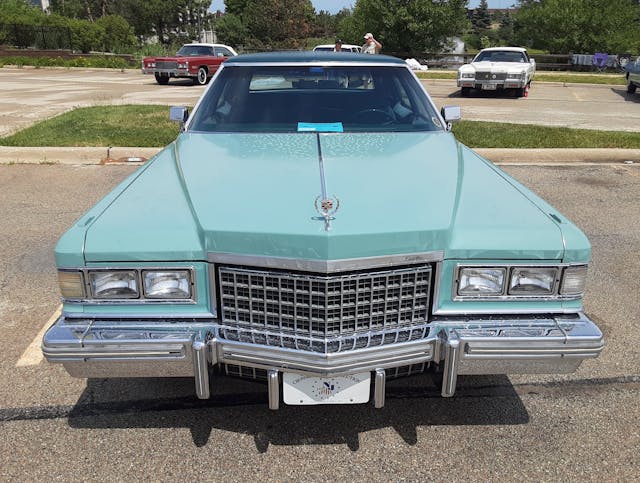
I’d say he’s a lucky man to own such a fine Cadillac. I’ve always loved these Fleetwood Broughams. I had a blue Pocket Cars toy version as a kid, and I guess we bonded (ha ha). I still have it too. It’s a little rough, but it survived to the present day.

As I’ve mentioned in other columns about cars at this show and the BCA show in neighboring Lisle the same day, my friend Jayson Coombes joined me at the shows, and he knew if he lost track of me, all he had to do was go to the green Brougham d’Elegance and I’d likely be there, snapping even more pictures!

In fact, another friend of mine, Andrew Bobis, was at the show, and at one point he took a picture from the CLC courtesy room on the top floor. As luck would have it, he actually caught me swarming the car—yet again! I was easy to spot, as I was sporting a coral golf shirt that day.
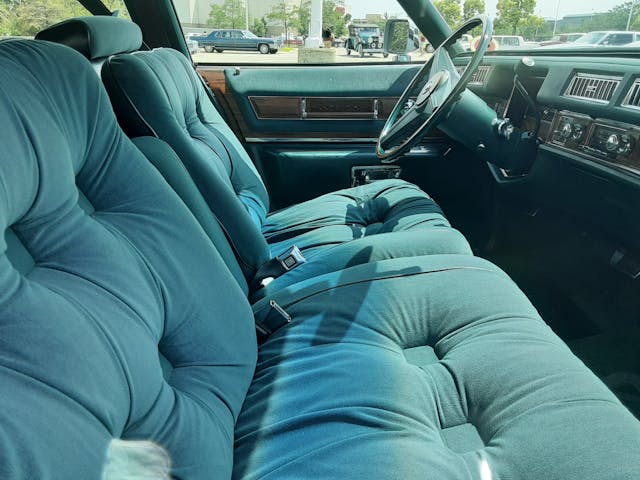
Starting in 1977, all Cadillacs (save the Eldorado) would be downsized, the first such time that had happened at Cadillac. The new cars were pretty nice too, but despite improved room and roadholding, they somehow didn’t have quite the presence of the ’76 and earlier Cadillacs. American luxury would never be the same.
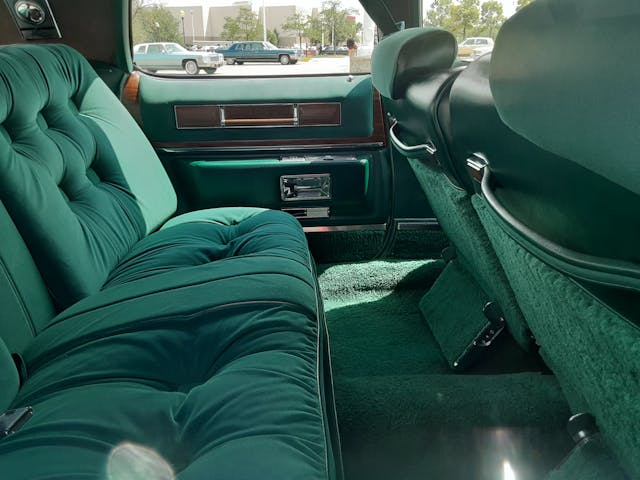
***
Check out the Hagerty Media homepage so you don’t miss a single story, or better yet, bookmark it. To get our best stories delivered right to your inbox, subscribe to our newsletters.


Beautiful car! 1975-1976 are some of the Cadillacs I like the most…great article, I always enjoy your writeups…keep ‘em coming.
This is a beautiful car I own a 1970 Fleetwood gold like the one in Madea and I also own a 92 Cadillac DeVille I love both of them but one day I do hope to have one of these years Cadillac
Gorgeous car, last of the four-wheeled aircraft carriers.
Great condition, though I shudder at what its gas mileage is.
Question: shouldn’t the hubcaps be color-matched to the body? Nearly all Cadillacs of this era were, if they were painted at all.
1976 Cadillacs wore black painted wheel covers. Many owners preferred the body color and had theirs repainted to match the car as is the case on my 1976 Eldorado convertible.
The ’77 Eldorado and downsized ’77 Fleetwood hubcaps were matched to the body color.
What a beauty!
“My” ’76 Caddy story: It was my senior year, 1977, Baltimore. Mom (especially) and Dad were very proud of our 76 Sedan DeVille, ordered from factory to Mom’s specifications : Kingswood Green Metallic, padded white vinyl roof, green pillow interior. $10,600. Dad was only a printer and worked lots of overtime to make that Caddy happen. (Starting with his brother’s used 63 SDV (in 69), a 69 Calais in 72, a 74 “Demo” in 74, and finally a brand new from factory! ANYWAY lol, it’s senior prom day. I had, almost jokingly, asked a couple days before if I could just maybe take the Cadillac to the prom. N. O.! so, took my 69 Ford Galaxie 500 to the car wash and did my best to make it “presentable “. So, I’m dressed in my tux headed out the front door…… when Dad hands me the keys.OMG!!!! What a nite!
Our 1976 Fleetwood (rose metallic) was 14 or 15 years old when I bought it in Tucson in 1990. It immediately needed a complete transmission rebuild (just a bit over $400, which seemed huge back then), but caused us no more trouble in the two years we owned it (other than the mechanical fuel pump going out; $200 mobile roadside repair somewhere in Colorado). We drove it across the continent twice, getting a solid 17 mpg or more at a steady 70 mph. I foolishly sold it in 1992 as gas prices were “spiking” (Gulf War, etc.) and bought an endlessly troublesome 1972 Volvo wagon that needed more work every few months than that Caddy had in two years. I wish I had hung onto that gorgeous beast.
Oops. Wrong spot. Reposted.
I gather it rained but why did someone wrap their car at the car meet? Is it made of sugar?
That car is gorgeous. I really like the colors. My grandfather was a Cadillac man. Though I didn’t appreciate them (or him) enough until after he was gone in ’72.
My question is, what’s with the steering wheel in that thing? Looks like it’s in the driver’s gut, and tilted at an odd angle. Maybe the tilt is for easy of entry and exit, but still looks too close to driver…
The steering wheel is telescopic. This man has it closer to him than a taller person would.
During the summer of ’76, I worked in an urban Cadillac delership service department between my junior and senior years in college. We used to prep, clean, detail and drive these amazing cars around the city. Our dealership building was built in the 30s and had narrow, steep ramps between the 4 floors. As “lot jockeys”we became very talented at, multi-point back-ups and parking. I remember a Phoenician Ivory Eldorado convertible witha matching top and interior in our showroom with an absurb (at the time) retail price adjustment of + $12,000! That was a stunning car.
Our 1976 Fleetwood (rose metallic) was 14 or 15 years old when I bought it in Tucson in 1990. It immediately needed a complete transmission rebuild (just a bit over $400, which seemed huge back then), but caused us no more trouble in the two years we owned it (other than the mechanical fuel pump going out; $200 mobile roadside repair somewhere in Colorado). We drove it across the continent twice, getting a solid 17 mpg or more at a steady 70 mph. I foolishly sold it in 1992 as gas prices were “spiking” (Gulf War, etc.) and bought an endlessly troublesome 1972 Volvo wagon that needed more work every few months than that Caddy had in two years. I wish I had hung onto that gorgeous beast.
Not reading all the posts which would have mentioned the fact that this Cad’s white walls are the incorrect size.
How much